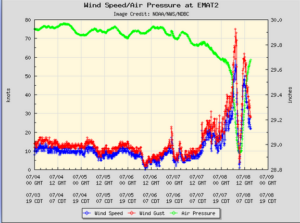Tropical Storm Francine was churning over the western Gulf of Mexico on Tuesday morning. At 8:00 a.m. EDT on Tuesday the center of Tropical Storm Francine located at latitude 24.5°N and longitude 94.9°W which put the center about 395 miles (640 km) south-southwest of Cameron, Louisiana. Francine was moving toward the north at 5 m.p.h. (8 km/h). The maximum sustained wind speed was 65 m.p.h. (105 km/h) and there were wind gusts to 80 m.p.h. (130 km/h). The minimum surface pressure was 990 mb.
A Hurricane Warning is in effect for the portion of the coast from Sabine Pass to Grand Isle. Louisiana.
A Tropical Storm Warning is in effect for the portion of the coast from Grand Isle, Louisiana to the Mouth of the Pearl River. The Tropical Storm Warning includes New Orleans. The Tropical Storm Warning also includes Lake Pontchartrain and Lake Maurepas. A Tropical Storm Warning is in effect for the portion of the coast from High Island, Texas to Sabine Pass, Louisiana. A Tropical Storm Warning is in effect for the portion of the coast from Port Mansfield, Texas to the Mouth of the Rio Grande River. A Tropical Storm Warning is in effect for the portion of the coast from La Pesca, Mexico to the Mouth of the Rio Grande River.
A Tropical Storm Watch is in effect for the portion of the coast from High Island to Port Mansfield, Texas. A Tropical Storm Watch is in effect for the portion of the coast from Barra del Tordo to La Pesca, Mexico.
Rainbands in the western side of Tropical Storm Francine were dropping heavy rain on parts of south Texas. A Flash Flood Warning is in effect for the area around Brownsville, Texas.
The circulation around Tropical Storm Francine showed signs of developing an inner core on Tuesday morning. The inner end of a rainband wrapped most of the way around the center of Francines’s circulation. An eye with a diameter of 25 miles (40 km) appeared to be forming at the center of Tropical Storm Francine. The eye was surrounded by a nearly complete ring of thunderstorms and the strongest winds were occurring in that ring of storms. Thunderstorms were occurring in bands in the northeastern part of Francine’s circulation. Thunderstorms were also occurring in bands in the western side of Tropical Storm Francine.
The size of the circulation around Tropical Storm Francine contracted a little as it began to resemble a typical tropical cyclone. Winds to tropical storm force extended out 140 miles (220 km) from the center of Francine’s circulation.
Tropical Storm Francine will move through an environment very favorable for intensification during the next 24 hours. Francine will move over water where the Sea Surface Temperatures are near 30°C. It will move under the middle of an upper level ridge over the western Gulf of Mexico. The upper level winds are weak near the middle of the ridge and there will be little vertical wind shear. Tropical Storm Francine will intensify to a hurricane during the next 24 hours. Francine could intensify rapidly after the inner core is fully formed.
Tropical Storm Francine will move around the western part of a high pressure system that extends from the western Atlantic Ocean to the Gulf of Mexico. The high pressure system will steer Francine toward the northeast during the next 24 hours. On its anticipated track, Tropical Storm Francine will move toward Louisiana. Francine will move faster toward the northeast on Wednesday when an upper level trough over the south central U.S. also begins to steer it toward the coast. Tropical Storm Francine will approach the coast of Louisiana on Wednesday afternoon. Francine will be a hurricane when it approaches the coast of Louisiana.
Tropical Storm Francine will bring strong winds and heavy rain to Louisiana. Francine will be capable of causing serious damage. Widespread outages of electricity are likely. Heavy rain is likely to cause flash floods.
Flood Watches are in effect for parts of Louisiana.
Tropical Storm Francine could cause a storm surge of up to 10 feet (3 meters) along parts of the coast of Louisiana.
A Storm Surge Warning is in effect for the portion of the coast from High Island, Texas to the Mouth of the Mississippi River. The Storm Surge Warning includes Vermilion Bay.

